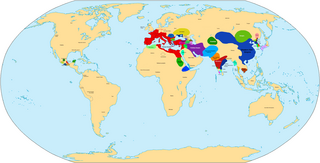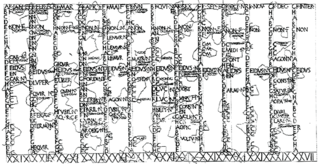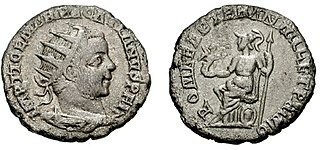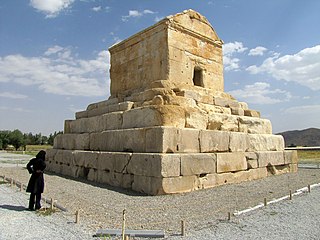The Julian calendar, proposed by Julius Caesar in 46 BC, was a reform of the Roman calendar. It took effect on 1 January 45 BC, by edict. It was the predominant calendar in the Roman world, most of Europe, and in European settlements in the Americas and elsewhere, until it was refined and gradually replaced by the Gregorian calendar, promulgated in 1582 by Pope Gregory XIII.

Year 27 BC was either a common year starting on Sunday, Monday or Tuesday or a leap year starting on Monday of the Julian calendar and a common year starting on Sunday of the Proleptic Julian calendar. At the time, it was known as the Year of the Second Consulship of Octavian and Agrippa. The denomination 27 BC for this year has been used since the early medieval period, when the Anno Domini calendar era became the prevalent method in Europe for naming years.
Year 23 BC was either a common year starting on Saturday or Sunday or a leap year starting on Friday, Saturday or Sunday of the Julian calendar and a common year starting on Friday of the Proleptic Julian calendar. At the time, it was known as the Year of the Consulship of Augustus and Varro. The denomination 23 BC for this year has been used since the early medieval period, when the Anno Domini calendar era became the prevalent method in Europe for naming years.

AD 14 (XIV) was a common year starting on Monday of the Julian calendar. At the time, it was known as the Year of the Consulship of Pompeius and Appuleius. The denomination AD 14 for this year has been used since the early medieval period, when the Anno Domini calendar era became the prevalent method in Europe for naming years.

Year 499 BC was a year of the pre-Julian Roman calendar. In the Roman Empire it was known as the Year of the Consulship of Aebutius and Cicurinus. The denomination 499 BC for this year has been used since the early medieval period, when the Anno Domini calendar era became the prevalent method in Europe for naming years.

AD 1 (I), 1 AD or 1 CE is the epoch year for the Anno Domini calendar era. It was the first year of the Common Era (CE), of the 1st millennium and of the 1st century. It was a common year starting on Saturday or Sunday, a common year starting on Saturday by the proleptic Julian calendar, and a common year starting on Monday by the proleptic Gregorian calendar. In its time, year 1 was known as the Year of the Consulship of Caesar and Paullus, named after Roman consuls Gaius Caesar and Lucius Aemilius Paullus, and less frequently, as year 754 AUC within the Roman Empire. The denomination "AD 1" for this year has been in consistent use since the mid-medieval period when the anno Domini (AD) calendar era became the prevalent method in Europe for naming years. It was the beginning of the Christian/Common era. The preceding year is 1 BC; there is no year 0 in this numbering scheme. The Anno Domini dating system was devised in AD 525 by Dionysius Exiguus.
Year 2 BC was a common year starting on Thursday or Friday of the Julian calendar and a common year starting on Wednesday of the Proleptic Julian calendar. At the time, it was known as the Year of the Consulship of Augustus and Silvanus. The denomination 2 BC for this year has been used since the early medieval period, when the Anno Domini calendar era became the prevalent method in Europe for naming years.
Year 7 BC was a common year starting on Saturday or Sunday of the Julian calendar and a common year starting on Thursday of the Proleptic Julian calendar. In the Roman world, it was known as the Year of the Consulship of Nero and Piso. The denomination 7 BC for this year has been used since the early medieval period, when the Anno Domini calendar era became the prevalent method in Europe for naming years.
Year 8 BC was either a common year starting on Friday or Saturday or a leap year starting on Thursday of the Julian calendar and a common year starting on Wednesday of the Proleptic Julian calendar. At the time, it was known as the Year of the Consulship of Censorinus and Gaius Asinius. The denomination 8 BC for this year has been used since the early medieval period, when the Anno Domini calendar era became the prevalent method in Europe for naming years.
Year 45 BC was either a common year starting on Thursday, Friday or Saturday or a leap year starting on Friday or Saturday and the first year of the Julian calendar and a leap year starting on Friday of the Proleptic Julian calendar. At the time, it was known as the Year of the Consulship of Caesar without Colleague. The denomination 45 BC for this year has been used since the early medieval period, when the Anno Domini calendar era became the prevalent method in Europe for naming years.

Year 87 BC was a year of the pre-Julian Roman calendar. At the time it was known as the Year of the Consulship of Octavius and Cinna/Merula. The denomination 87 BC for this year has been used since the early medieval period, when the Anno Domini calendar era became the prevalent method in Europe for naming years.
Year 84 BC was a year of the pre-Julian Roman calendar. At the time it was known as the Year of the Consulship of Carbo and Cinna. The denomination 84 BC for this year has been used since the early medieval period, when the Anno Domini calendar era became the prevalent method in Europe for naming years.
Year 16 BC was either a common year starting on Monday, Tuesday or Wednesday or a leap year starting on Monday or Tuesday of the Julian calendar and a common year starting on Sunday of the Proleptic Julian calendar. At the time, it was known as the Year of the Consulship of Ahenobarbus and Scipio. The denomination 16 BC for this year has been used since the early medieval period, when the Anno Domini calendar era became the prevalent method in Europe for naming years.
Year 15 BC was either a common year starting on Tuesday, Wednesday or Thursday or a leap year starting on Wednesday of the Julian calendar and a common year starting on Monday of the Proleptic Julian calendar. At the time, it was known as the Year of the Consulship of Drusus and Piso. The denomination 15 BC for this year has been used since the early medieval period, when the Anno Domini calendar era became the prevalent method in Europe for naming years.
Year 252 BC was a year of the pre-Julian Roman calendar. At the time it was known as the Year of the Consulship of Cotta and Geminus. The denomination 252 BC for this year has been used since the early medieval period, when the Anno Domini calendar era became the prevalent method in Europe for naming years.
The year 539 BC was a year of the pre-Julian Roman calendar. In the Roman Empire, it was known as year 215 Ab urbe condita. The denomination 539 BC for this year has been used since the early medieval period, when the Anno Domini calendar era became the prevalent method in Europe for naming years.
A calendar era is the year numbering system used by a calendar. For example, the Gregorian calendar numbers its years in the Western Christian era. The instant, date, or year from which time is marked is called the epoch of the era. There are many different calendar eras such as Saka Era.
The Ancient Macedonian calendar is a lunisolar calendar that was in use in ancient Macedon in the 1st millennium BC. It consisted of 12 synodic lunar months, which needed intercalary months to stay in step with the seasons. By the time the calendar was being used across the Hellenistic world, seven total embolimoi were being added in each 19-year Metonic cycle. The names of the ancient Macedonian Calendar remained in use in Syria even into the Christian era. The Macedonian calendar was in essence the Babylonian calendar with the substitution of Macedonian names for the Babylonian ones. An example of 6th century AD inscriptions from Decapolis, Jordan, bearing the Solar Macedonian calendar, starts from the month Audynaeus. The solar type was merged later with the Julian calendar. In Roman Macedonia, both calendars were used. The Roman one is attested in inscriptions with the name Kalandôn gen. καλανδῶν calendae and the Macedonian Hellenikei dat. Ἑλληνικῇ Hellenic. Finally an inscription from Kassandreia of about ca. 306-298 BC bearing a month Ἀθηναιῶν Athenaion suggests that some cities may have used their own months even after the 4th century BC Macedonian expansion.

The Byzantine calendar, also called "Creation Era of Constantinople" or "Era of the World", was the calendar used by the Eastern Orthodox Church from c. 691 to 1728 in the Ecumenical Patriarchate. It was also the official calendar of the Byzantine Empire from 988 to 1453, and of Kievan Rus' and Russia from c. 988 to 1700. Since "Byzantine" is a historiographical term, the original name uses the noun "Roman" as it was how the Eastern Roman Empire continued calling itself.










